Agalinis
Agalinis (false foxglove) is a genus of about 70 species in North, Central, and South America that until recently was aligned with members of the family Scrophulariaceae.[2] As a result of numerous molecular phylogenetic studies based on various chloroplast DNA (cpDNA) loci, it was shown to be more closely related to members of the Orobanchaceae. Agalinis species are hemiparasitic, which is a character that in part describes the Orobanchaceae.
| Agalinis | |
|---|---|
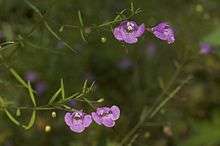 | |
| Agalinis tenuifolia | |
| Scientific classification | |
| Kingdom: | Plantae |
| Clade: | Tracheophytes |
| Clade: | Angiosperms |
| Clade: | Eudicots |
| Clade: | Asterids |
| Order: | Lamiales |
| Family: | Orobanchaceae |
| Tribe: | Pedicularideae |
| Genus: | Agalinis Raf. |
| Species | |
|
About 70; see text | |
| Synonyms[1] | |
| |
The first detailed study of this genus began with Francis W. Pennell around 1908, and his earliest major publication of the North American members of this genus appeared in 1913. Dr. Judith Canne-Hilliker began to revise Pennell's treatment in 1977. Her taxonomic, anatomical, and developmental studies have greatly enhanced our understanding of this sometimes perplexing group. In particular, her studies of the seed surfaces using electron microscopy has shown that the seeds are diagnostic for delimiting species and has resulted in a realignment of Pennell's classification of the group. In the 1990s Gregg Dieringer investigated the reproductive ecology of several Agalinis spp., to include the self-incompatible Agalinis strictifolia and the autogamous bee-visited Agalinis skinneriana. Much remains to be studied in this regard, however.
One species of Agalinis, Agalinis acuta, is federally listed. This is mainly due to continued habitat loss within its historically known range. There are a number of species in North America that are ranked at the state and federal level. However, many of the species considered rare are ranked at the state level and represent species on the periphery of their range. There are a number of rare (and endemic) species that are not noted at the state or federal level, and the biogeography of this group in North America has yet to be studied in detail, and is poorly understood.
Species
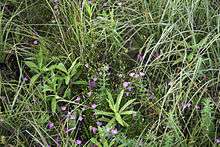 | Agalinis acuta | sandplain false foxglove |
| Agalinis aphylla | scaleleaf false foxglove | |
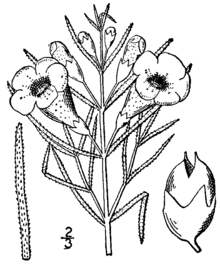 | Agalinis aspera | harsh stem false foxglove |
| Agalinis auriculata | earleaf false foxglove | |
| Agalinis caddoensis | Caddo false foxglove | |
| Agalinis calycina | Leoncita false foxglove | |
| Agalinis densiflora | Osage false foxglove | |
| Agalinis divaricata | pineland false foxglove | |
| Agalinis edwardiana | Edward's Plateau false foxglove | |
 | Agalinis fasciculata | tall false foxglove |
| Agalinis filicaulis | delicate false foxglove | |
| Agalinis filifolia | Florida false foxglove | |
_(25765765862).jpg) | Agalinis gattingeri | Midwest false foxglove |
| Agalinis georgiana | Georgia false foxglove | |
| Agalinis harperi | Gulf Coastal Plain false foxglove | |
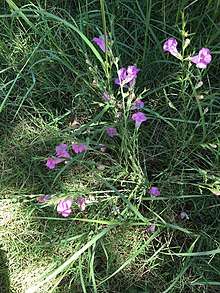 | Agalinis heterophylla | prairie false foxglove |
| Agalinis homolantha | San Antonio false foxglove | |
| Agalinis itambensis | ||
| Agalinis kingsii | ||
| Agalinis laxa | long-pediceled false foxglove | |
| Agalinis linifolia | perennial false foxglove | |
| Agalinis maritima | saltmarsh false foxglove | |
| Agalinis nana | ||
| Agalinis navasotensis | Navasota false foxglove | |
| Agalinis neoscotica | Nova Scotia false foxglove | |
| Agalinis obtusifolia | variable false foxglove | |
| Agalinis oligophylla | ridgestem false foxglove | |
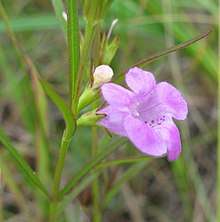 | Agalinis paupercula | boreal false foxglove |
| Agalinis plukenetii | chattahoochee false foxglove | |
| Agalinis pulchella | savanna false foxglove | |
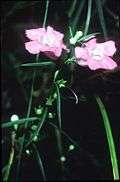 | Agalinis purpurea | purple false foxglove |
| Agalinis setacea | threadleaf false foxglove | |
| Agalinis schwackeana | ||
| Agalinis skinneriana | Skinner's false foxglove | |
| Agalinis strictifolia | clasping false foxglove | |
 | Agalinis tenuifolia | slender false foxglove |
| Agalinis viridis | green false foxglove |
References
- "Agalinis Raf. | Plants of the World Online | Kew Science". Plants of the World Online. Retrieved 2020-05-30.
- http://www.theplantlist.org/browse/A/Orobanchaceae/Agalinis/ | The Plant List reference for Agalinis
- PLANTS Profile for Agalinis (false foxglove) | USDA PLANTS Profile for Agalinis
- Souza, VC, SI Elias, & AM Giulietti. 2001. Notes in Agalinis (Scrophulariaceae) from Brazil. Novon 11:484-488.